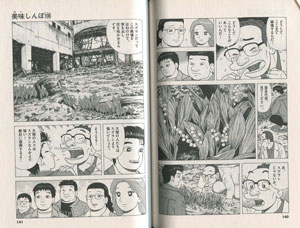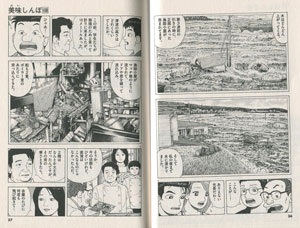An essay on
Hisaichihen. Megenai hitobito: Oishinbo
Grace Song, Bryn Mawr College, Class of 2014
Oishinbo is a Japanese food manga graphic novel series written by Tetsu Kariya and drawn by Akira Hanasaki. According to L. Brau, the title is a clever hybrid of the Japanese words for delicious oishii and someone who likes to eat kuishinbo (Brau, 2004). The genre of this type of mangais known as gurume (gourmet), and when Oishinbo started in 1983, it soon became very popular and played as a major factor for the "gurume boom" in the late 1980's in Japan. It has also been turned into a successful anime series.
The story follows the protagonist Shirou Yamaoka, who is a food journalist working for a newspaper company to create "The Ultimate Menu" in competition with its rival company. Oishinbo is one of the longest running series in Japan, and perhaps it is because of the fact that it exposes the readers to the different local cuisines of Japan and introduces local specialty ingredients and traditional methods of cooking.
Because Oishinbo has been running for a quite long time, the changes in the Japanese society are also reflected in the storyline. For example, when the series was first published in 1983, the economy was booming in Japan and the image of hard working "salary men" became central in the Japanese middle class. While Japan was growing day by day in the technological development and production as it strove to place itself as an economic superpower among the western countries, the desire to hold onto the traditional Japanese values is also expressed in the series. "Although Oishinbo introduces foreign, exotic, and sometimes costly foods, it has tended to assume a conservative stance, advocating loyalty to Japanese tastes" (Brau, 2004). For example, in one episode of the series, "a worker tries to impress his date by eating elegant French food, only to realize that nothing is more satisfying than ramen noodles" (Shwartz, 2012). In another episode, "Yamaoka praises a dish that the cook introduces with the phrase Nihonjin ni umarette yokatta ('I'm glad I was born Japanese,' to be able to appreciate and enjoy this very Japanese dish, in other words)" (Brau, 2004).
Since the 3.11 disaster, a special volume of Oishinbo, which illustrates the aftermath of the triple disaster in Tohoku area and its effects on the food industry, was released. Although figure 1, a specific scene from pages 140 and 141 from this special volume, does not have any image of food, it portrays the destruction of land after the disaster, as well as frustration and remorse felt by those who feel as though they have no power to help the situation. As the subtitle of this volume (Vol. 108), which translates to "People who do/will not lose", suggests, the strength and flexibility of the affected people are compared to the lily of the valley that have sprung on the affected soil. This scene is significant because it not only reveals the grim reality of the aftermath left by the most devastating disaster in the Japanese history but also a sign of hope in the midst of it.
In the first few frames, one of the characters laments the state of a building complex that is left bare and destroyed as others share his feelings and look on with worrisome eyes. In the next scene, however, Shiro Yamaoka, the protagonist points out the flowers and consoles the other by saying that the people of Ôtsuchi (a town in Iwate prefecture) are stronger than the lily of the valley flowers. Through these two pages, author and artist send a hopeful message to the readers that Japan has ability to regenerate and grow, and reinforces the image of "people who will not lose".
Interestingly, there is not much dialogue or text in this excerpt. Many scenes simply show characters' faces, or facial expressions to be more exact. While manga lacks an ability to pass down a large amount of knowledge in a concentrated manner the way heavily written text can do or provide dynamic movements in vivid colors such as film does, it successfully combines the elements of the other two media. Pages 140 and 141 are a good example that shows such strength of mangaas a medium to deliver a story. Although the drawing is in black and white and stationary, it provides a realistic visual image of the situation. If a reader looks at this particular scene for a very long time, she may even start to feel as though she is inside the cartoon, witnessing the illustrated scene while standing with the other characters. Detailed and meticulously drawn image of the building and location it is in on the top of page 141 highly contrasts with the simple lines that were used to draw human figures. Reader's eyes are naturally drawn to this scene, and then remain there for a while. By not overwhelming the pages with long texts or deliberate dialogues, the author not only encourages the reader to actually read the few words that exist in some scenes but also create a sense of silence in the moment, similar to the technique used by a documentary maker to draw the viewer's attention solely to the visual image by "letting a picture to speak for itself".
As it is a gurume manga, a large portion of the volume is consisted of images of cooking and food. This volume is special in that it focuses on chefs or people with profession that deals with food who live in the disaster stricken areas. For example, pages 36 and 37, as shown in figure 2, illustrate a scene of a chef who is showing the characters the photos of the aftermath. It is apparent that not only the physical neighborhood has been destroyed but also the livelihood of the family. The picture of the chef's destroyed kitchen especially shows how the main source of his living was taken away by the earthquake and tsunami. Several pages that follow them, however, depict the chef and his young son preparing various type of traditional food such as squid sushi and a nabe or a hot pot stew dish, as shown in figure 3. This series of scenes is important, because it shows that while the tsunami has destroyed much of people's living, it was not able to destroy their spirit and passion. The presence of the chef's young son in this chapter is also significant, since it sends a hopeful message that the tradition will not be forgotten, that it will be continued by being passed to the next generation. This message emphasizes resilience, as well as the perseverance of Japanese people.
In a larger context, manga artist and author's efforts to raise awareness of the 3.11 disaster through their professional medium, further reveals the efforts to reflect, learn, and move on toward a hopeful future.


